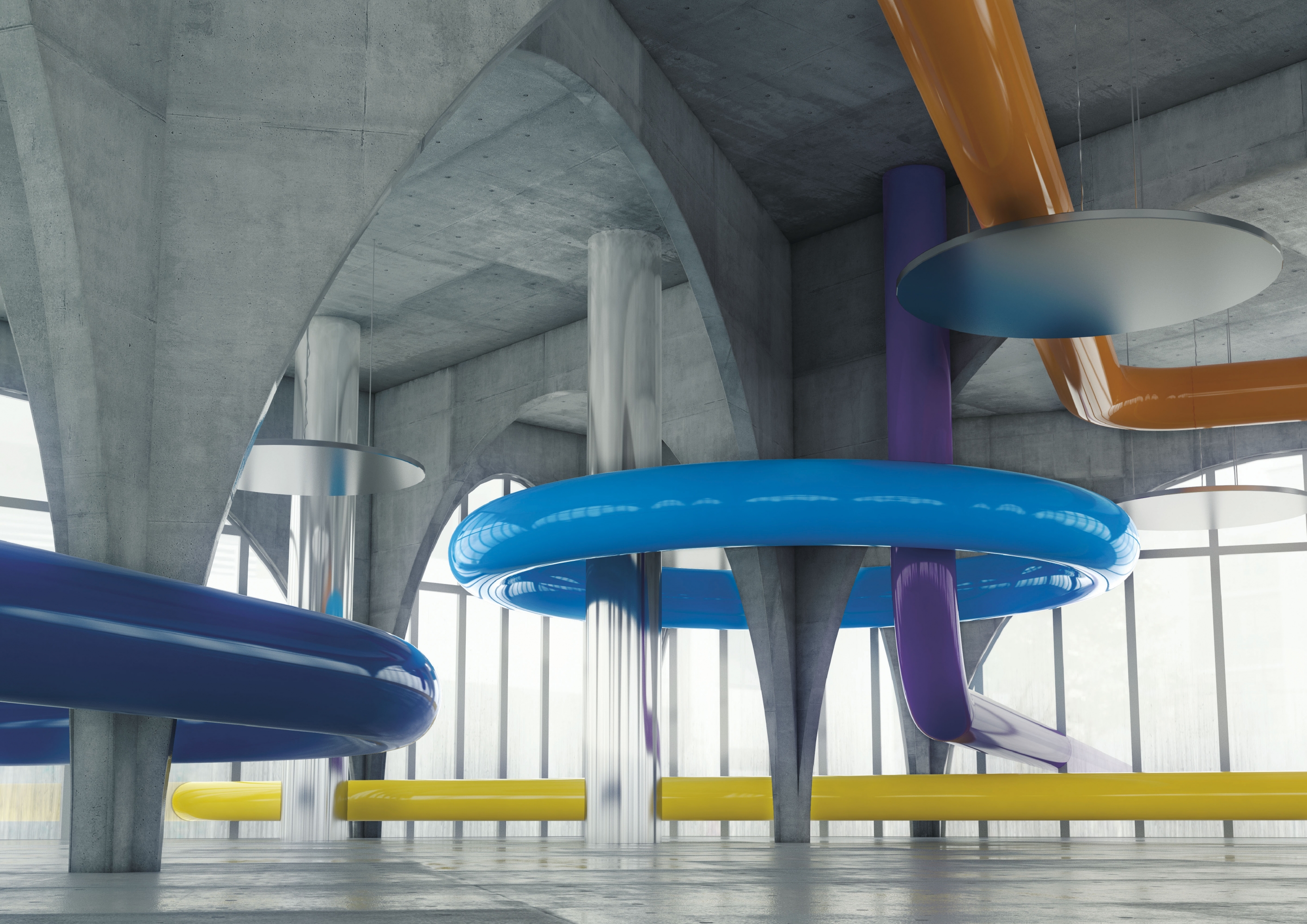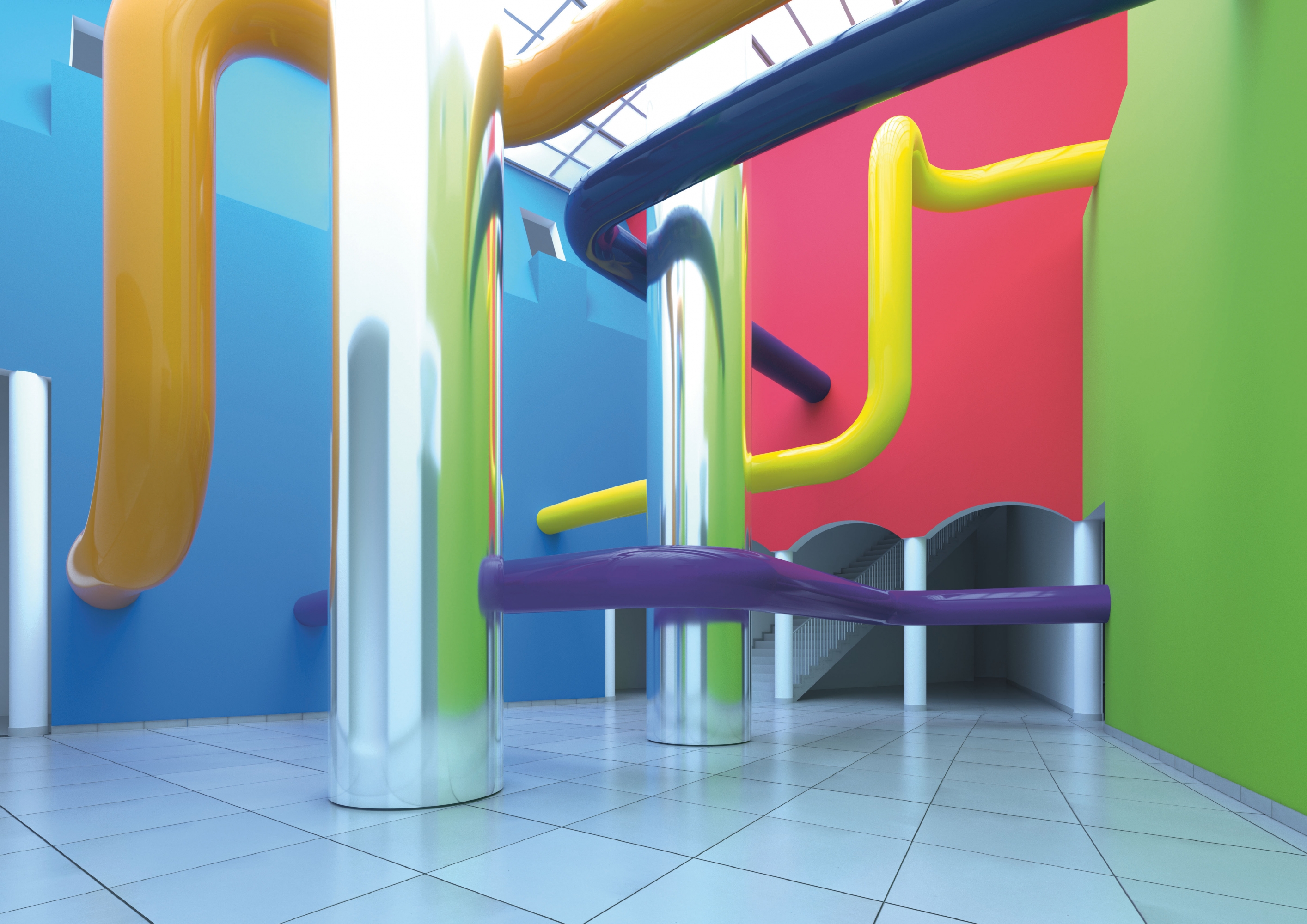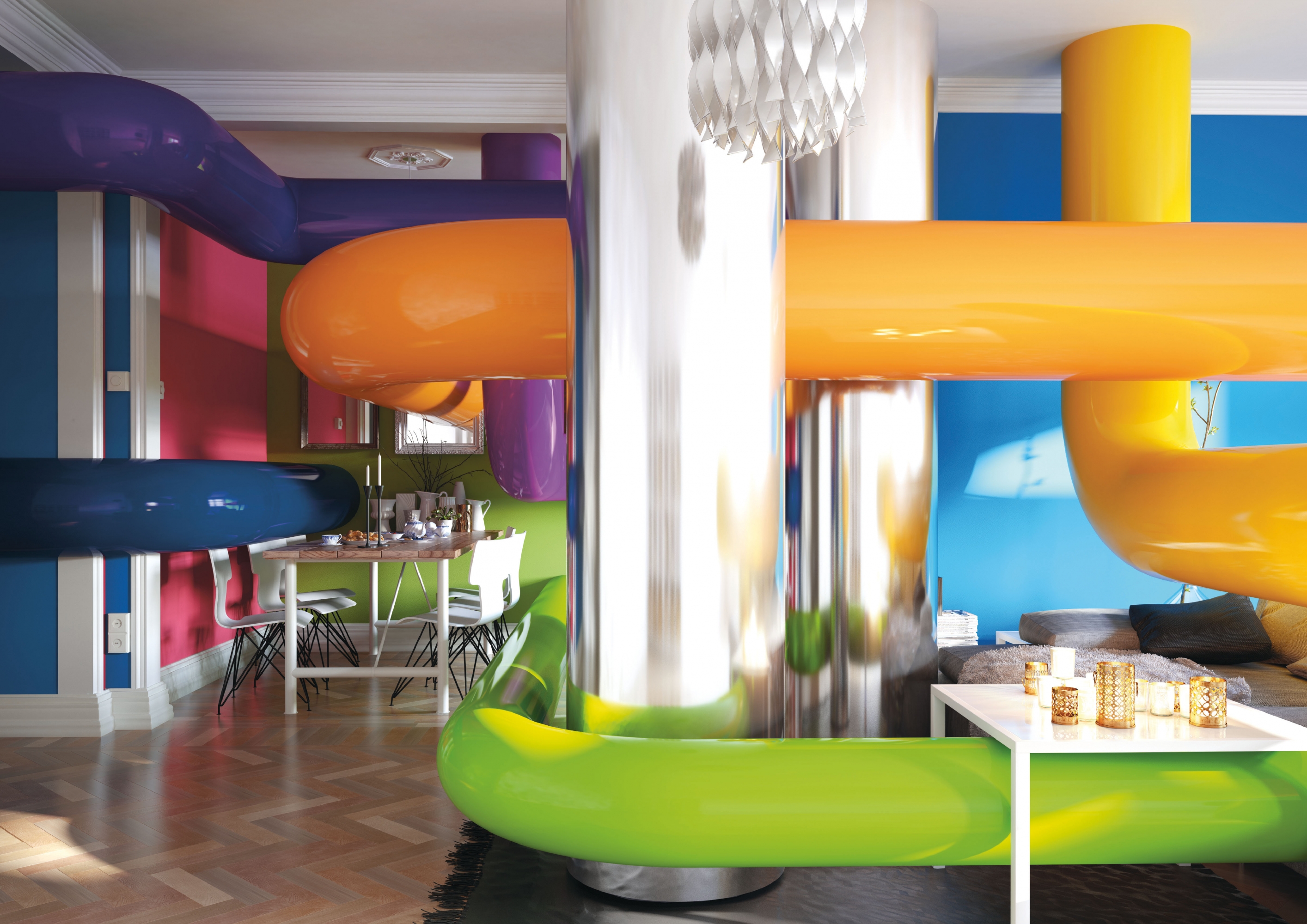Manuel Roßner the founder of Float gallery (named cermâ until 2015) one of the very first virtual galleries, has released a new show called “Ultralight Beam”.
We’ve interviewed Roßner, who has been eagerly exploring the possibilities of online spaces, to ask about numerous topics such as his curation at cermâ for “What we call painting” and “Act Natural”. We will also inquire into his past works and how he intends to interact with the world next.
What kind of space is an online gallery?
With the physical is gone, all that is left is the artist’s concept and thought process for creation. In recent years the already dwindling distinction between the genres of “paintings” and “sculptures” has all but disappeared.
In this space all paintings and sculptures becomes a textured light upon a display screen. What are we to call these works in such a mysterious space?
Could you tell us how you started “cermâ”?
It was about 10 years ago when I was about 15. For the first time, I had a 3D software and I was making maps for “Counter Strike” and such things. But shooters are a quite limited use and I was always wondering what else you could to in such a space. You can use it for architecture, for movies or for planning something. But still, that relates to physical creations. That’s why I started thinking about having a gallery to work in there. And then in 2012 it was a good time, because also artists used 3D-Software more often and I started the project.
How did you learn to use the 3D software?
It was self-teaching. I started when I was quite young like 15. I was just curious to have this challenge or possibilities. And I’m still learning. It’s astonishing how the developers of the software create tools so close to the physical world.
“cermâ” was started from zero by yourself?
All things except for the art works, practically. Just for having fun in the space where the first 3 exhibitions were. But now I changed the name from “cermâ” to “Float gallery”.
How is it different “cermâ” to “Float gallery”?
The concept is the same, but I felt like I didn’t use its full capacity. I didn’t have regular exhibitions and didn’t have enough time for it. But now I want to put more energy in it. And I started to translate the contents into as many languages as possible. I also try to find sponsors because it’s necessary to make sustainable work. I thought about having a commercial gallery where people can buy art works, but for the moment I dismissed the idea.
That’s nice. Could you introduce the members of “cermâ”?
The first show was curated by myself. For the second one, it was “SPAMM”, I invited Thomas Cheneseau and Systaime. The next show will be curated by me again. At the same time I’m planning a show in China later this year, with a curator from Shanghai. The global accessibility of the exhibitions is a good way to switch to different cultures.
I think “SPAMM” is inspired by the Internet art in the 90’s. Do you have any favourite artists in the 90’s?
When I was creating “cermâ”, I rather looked at artists like Marcel Broodthaers. I found him really interesting. He had created “Musée d’Art Moderne, Départment des Aigles” in the late 60’s.
So what kind of art is that?
It’s a experiment where he reflects the conditions of modern art. He focuses on the “Department for Eagles” of his Museum of Modern Art. Because the eagle is a symbol of the German Federal Republic you can also find it on gold bars and that’s why they became a part of his collection for example. Later the “Départment des Aigles” declared bankruptcy and he sold his collection. Of course the gold was very valuable. It was not because of the artwork, but because of the raw material. Another day he created a floorplan of his building at a beach in Belgium during low tide. He took photos and when the sea water came, everything vanished, except for the photos. When you think about online exhibitions, you have a photo but the space doesn’t really exist. I mean, the space never existed. There was some kind of connection.
How did you start curating? Why did you start?
The title of the first exhibition was “What we call painting”, on one hand it’s asking “Who are ‚we‘?” and on the other hand “What is painting?”. I was looking for artists who had a digital approach to painting and I found Jeremy Rotsztain, Jeremy Bailey and Andreas Nicholas Fischer. And they all have a kind of interesting way to be related to the idea of painting. So I invited them. I just wrote them asking “Hey, how do you like this? Do you want to show something?” and they agreed. It was really exciting!

You are doing the Internet gallery. Why did you choose “painting” as the first theme? “Painting” means usually actual paintings. It sounds a kind of an opposite concept, a virtual gallery and real painting. Why did you choose that?
I think that I wanted to relate it to the usual artwork back then. Also I wanted to use the white cube despite I could use virtually every space for an online gallery. I was interested in the relation of the new tools and the existing context of the art world.
As a painting is common, people call it art. Do you mean painting is the most popular in the art world?
Yeah, also the title was asking, “Can we extend this meaning to what those guys do?” with Jeremy Bailey and his brush. Not a brush but a tracking though, saying, “Hey, I’ve made this beautiful canvas. It’s cool. You don’t have to clean your brushes anymore. Every time you erase it, you can create something new”, which is really different to classic painting. If you destroy it, it can’t be forever. This is like, “Hey, every time you can have a new thing to create”. And it’s interesting, I guess when you grab the technology of this style in your head and go to the classic gallery, it’s so different. Maybe I was interested in the gap and how you can image it.
The title, “What we call painting” is a kind of challenge. Why are you challenging? Or what’s your challenge?
I extended the cultural techniques of the art world towards the new technology focused society. Everybody staring at the phone all the time, but the majority of things you saw in galleries back in 2012 were canvases, and they still are. Of course that’s the way galleries work and physical painting is definitely not obsolete. But at the same time it seems more natural to me and the artists I’m working with to use digital tools for their work and there should also be structures that support it.
Could you tell us about your new art exhibition, “Ultralight Beam”? How did you get the idea?
Ultralight Beam is sort of the Antithesis to the white cube and it’s aesthetics. I approached the classic gallery space with a thinking rooted in software engineering. So instead of the neutral white walls that isolate the artwork you’ll have super intense colors that help you distinguish different elements from each other. In addition to that there are chrome columns where you’re able to trace light beams easier because they have those strong colors from the walls they’re reflected from. In the end I’ve extended this concept to different other locations, like a space that’s a bit similar to Toyo Itos library at Tama Art University, which I found really impressive when I visited.
I found it interesting that the exhibition spaces connect with each other. Why did you use several spaces, not just White Cube?
I wanted to see the power and ignorance of these elements derived from infrastructure in different contexts. The technological approach towards space in relation to the white cube of course, but also in a private living room and a Rococo-Chateau. A bit like Wifi, which doesn’t care about the walls and history it transcends either. On the other hand it’s also a specificity of the medium that allows you to copy paste and see if something like this fits into a particular space.

Your gallery itself is already an art. Not just like a space, or just a gallery. It’s like an art project.
Yeah, I also definitely started from that idea, with an artistic approach like “What is this space?”. I didn’t have commercial intention or technical intention.
Is there any difference between doing in a physical gallery and doing on an online gallery in curation?
Yeah definitely. Doing online work is not related to a location in the first place and „hanging“ or „installing“ is something completely different. You don’t have to ship, but you need go through a production process that is similar to producing special effects for a movie.
Not just a gallery, but curation online has more possibility. Curating means collecting artworks, editing, writing statements with a concept and artistic attitude.
Yes the conceptual part is similar. For example how you chose an artwork and a topic or how you relate pieces to each other is as important as in a physical space. And in the end the text is very important, because it translates the exhibition into meaning on an additional level.
What else do you think you can do online as curation?
I have some ideas and I’m excited to do the next steps, I’ll let know when we’re ready.
Is that what nobody has done yet?
Yeah, there’s a lot, you can play a lot. With spots where you usually can’t make an exhibition. And new spaces that didn’t exist before, and couldn’t even be built because of physics.

Online gallery has more advantages than a real gallery. We can access there for 24 hours, it’s easy to make extension rooms, it has sustainability and it means no cost to run. What do you think is the better points of an online gallery than a real gallery?
You can reach a lot of people from different places. That’s really cool. Of course you need a device to see it, but a lot of people already have one and you don’t have to take a plane to see an exhibition. Now I’m also translating it into many languages to make the shows even more accessible. When I was in Shanghai, I showed images from a past show to a Chinese artist. He recognized them because he had seen them already 3 years before. I started with no budget, if I did it in the physical world, my reach would be way lower. Though also in the real world, you can rent a big space in the gallery district. You produce impressive work and catalogs and so on, if you have the money. At the same time the internet is endless and webspace is affordable, but hierarchy persists. There it’s probably rather the Google rank that counts. Also the perception has specific qualities. If you’re wearing a VR Headset you’re in additive color space. That means, that basically every surface is glowing, which is would be unnatural for a physical space. I wonder how Mark Rothko would have related to that.
Because lots of things are becoming so vague like no borders, we don’t know what is art or what is photo. For example, when we buy online art, it’s a really virtual thing. But people pay for it. So it seems like an art world is becoming different from the past. And especially Internet art is hard to sell, so the artist need to be sustainable to make art. How do you think we can survive to live or work in this society ? Do artists need to have daily job or to be a part time artist? How can we monetize, I mean, make money and make artwork sustainable? What do you think?
When you think about the early days of the internet people put a lot of hope into it for democratizing information and access. Almost 30 years after the discussion changed a lot. There’s a lot of money involved and also the possibility to spread information is seen controversial in some situations, but that’s another story.
What I find surprising is how tentative public institutions use the net. Despite a few great examples they stick to their walls while skipping the great potential of online shows. And here monetization plays definitely an important role unfortunately. Not to provide a physical object also prevents people from collecting your work in an exclusive way, which is the foundation for the insane prices we know from todays art world. Rejecting this attention, life-style and wealthy public is probably difficult for many museum’s decision makers and of course meeting real people and counting them instead of numbers in tracking software is also more satisfying.
But of course there’s also progress and people will produce work that reflects contemporary circumstances of live naturally, there’s no way around.
Also the question of monetization is not specific to the art world. Music and film business have been dealing with it way longer. With advances in technology also production and service industries need to rethink their models. Studies find that in the next 15 years 40 to 60 percent of jobs will be done by machines, so the income struggles of digital artists are only a small part of a problem questioning society as a whole. A possible answer is a Universal Basic Income…
It is a good idea for small country like Switzerland.
Of course Switzerland is in a special situation, but no country is the same. Because the big tech companies work worldwide, they are also changing every economy and international corporation is more important that at any time before.
It’s a great idea though.
Of course there a still a lot of questions. And there are also different ideas of how you would actually implement it. How do you transfer the important role of a paid job played in one’s life to free occupations and a lot more concerns? Wouldn’t everybody just hang around? Though switching from a rejective to a productive approach towards automation seems attractive and unavoidable to me at the same time. What do you think about it in Japan?
Automation is nice but now only those who invented automation or something like that become super rich such as IT people. And people who are not doing something in the industry are poor. Between the poor and the rich, the gap is becoming bigger. Even if technology gets better and automation has progressed, there are only few people who can get the benefit. So basic income might be a good idea.
Yeah when I book a hotel a big share of the price goes to a company in the Netherlands or California, when I search for information and write to my friends it’s the same thing. And since more and more service work in that way that’s not a model for a bright future for everyone, I guess. Together with other people working in our field, we’re working on a project that addresses this discussion directly. It will be released soon, we will keep you posted!
Manuel Roßner
http://www.manuelrossner.de/
“Ultralight beam” is now online on www.float.gallery and at 1822-Forum, Fahrgasse 9, 60311 Frankfurt/M., Germany until February 25, 2017